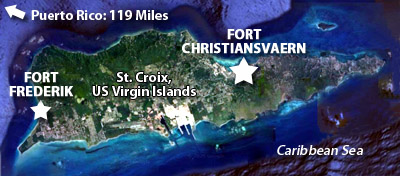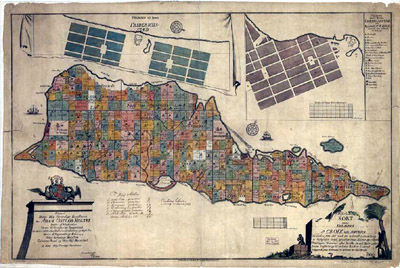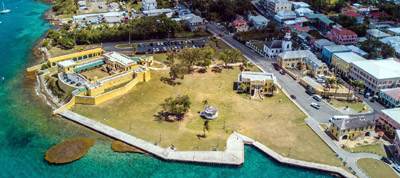 |
Fort Christiansværn
Christiansted, St. Croix, US Virgin Islands
|
|
 |
Constructed: 1738-1749, 1835-1841
Used by: Denmark, Great Britain
Conflicts in which it participated:
None
|
History once again begins with the doings of Christopher Columbus (1451-1506). Without him, the Western Hemisphere may never have existed! The Italian explorer willed St. Croix Island (initially known as Santa Cruz) into being on November 14, 1493, and here's where my theory of Columbus inventing the hemisphere falls apart, because he and his crew were immediately attacked. |
 |
 |
|
...and if there was someone there to attack the newbs, then there must have been someone around prior to Columbus' arrival. A series of different indigenous persons had lived on the island dating back to the earliest days of anno Domini, and the present spear-wielders were the Kalinago. Columbus was personally unscathed in the fracas, and named the cape at which he was attacked Cabe de la Flecha, Cape of the Arrow. The Spanish did not opt to colonize what would later be called the Virgin Islands at that time, but everybody on Santa Cruz either died or left by the 1590's anyway.
|
 The Dutch colony of St. Croix in 1754. Look at all those straight lines! The Dutch certainly were an orderly lot. A blowup of the city of Christiansted is at top right, and Fort Christiansværn is visible therein. A blowup of Frederiksted is also at the top of this map, featuring Fort Frederik, but we're not talking about Fort Frederik right now so let's not get ahead of ourselves, all right? |
 |
The 17th century brought folks from Holland, England, France and Spain to Santa Cruz, all of whom were predictably unable to get along with each other. By the middle of the century the French were in charge, with a colony of 300. The Knights of Malta, a military order of righteously sword swingin' Catholics who spent time on various islands at the behest of various French kings in the Middle Ages (check out our Fort Ricasoli page for a lot more about the Knights, should you be so inclined), ruled Santa Cruz from 1651 to 1664. The French West India Company became the island's authoritative body after the Knights, but the colony was evacuated to San Domingo in 1695, due to fears of everyone being murdered by the wicked English during the Nine Years' War (1688-1697). |
|
|
Santa Cruz sat uninhabited for the next 38 years. Surely the departed souls of all the indigenous persons who had been expelled from the island were like, "y'know, if you weren't gonna even use the island, maybe you could've just left us alone...?" Nonsense, departed indigenous souls. Europeans gotta do what Europeans gotta do. In June of 1733, the Danish West India Company purchased Santa Cruz (soon to be renamed St. Croix, I promise) from France for 750,000 livres. It's difficult to say how much that would be in "today money," but I can tell you that it equated to 15,000,000 sols, or 180,000,000 deniers. Does that help? You're welcome.
|
Wisely, the Danes wasted little time fortifying their newest colony, which was chiefly intended to support plantations for sugar and cotton. Frederik Moth (1694-1746), the Danish governor of St. Croix and St. Thomas (which, along with the island of St. John, became known as the Danish West Indies), identified the location for a new starfort to be built to protect the town of Christiansted from the ever-present scourge of piracy in September of 1733, atop the ruins of a French fort, Fort Saint Jean, which dated to 1645 and had been destroyed by a hurricane.
Anyone who has operated a sugar or cotton plantation (and whom of us hasn't?) will tell you that it's back-breaking, grueling work...which makes it perfect for slavery! By 1754 Christiansted had 83 white inhabitants, each of whom owned from one to 66 African slaves. Slaves were the ones building stuff on St. Croix, which means we can thank them for the construction of Fort Christiansværn. Thanks, slaves!
Another reason a starfort was needed was for a secure location at which the white folks could shelter during unreasonable slave revolts. The enforcement of custom duty collection, the imprisoning of persons in desperate need of imprisonment, and the housing of St. Croix's first governors were Fort Christiansværn's other initial missions.
|
 |
A plan of Fort Christiansværn in 1836, which looks a lot like the fort at the top of this page! Other than the guns getting fewer and bigger, it hasn't changed much in 184 years! |
|
One of Fort Christiansværn's inmates was Rachel Faucette, mother of US Founding Father Alexander Hamilton (1757-1804). Rachel had married a Danish merchant and planter on St. Croix in 1745 when she was sixteen, and in 1750 she refused to live with him any longer. Under Danish law, this made her worthy of imprisonment, and she spent several months in a 10- by 13-foot cell in the starfort of our current interest. Upon release she fled to the British West Indies, where she met the man with whom she would produce Alexander Hamilton, and history breathed a sigh of relief.
|
 The business end of Christiansted: Lovely yellow! The freestanding rectangular thing in the center is the Customs House; bottom right is the Scalehouse; to the right of the Customs House is the old Danish West India Company's warehouse...and our lovely fort is on the left. Click it, it gets big enough to see. |
 |
Things might have continued into rosy eternal perpetuity for the plantation owners on St. Croix, had the Danes not joined Russia, Sweden and Prussia in the Second League of Armed Neutrality in 1801. The First such league was formed in 1780, during the War of American Independence: Several European nations isolated Britain, and resisted the Royal Navy's interference with European shipping. This first League was reasonably successful in its intended purpose, and so when a similar opportunity arose during the War of the Second Coalition (1798-1802), it seemed like a swell idea to get the ol' band back together and isolate Britain again!
|
|
|
Great Britain, however, was having none of it this time around. Britain's Royal Navy attacked Copenhagen in 1801, destroyed much of the Danish Navy, and relieved Denmark of the Danish West Indies! An abashed Denmark left the League of Neutrality, and the British returned their Caribbean islands in 1802. Having somehow not learned their lesson, Denmark cozied up with Napoleon (1769-1821) in 1807, which resulted in another British seizure of the Danish West Indies. Like the previous similar incident, the seizure was bloodless, the Danish authorities having been ordered not to resist. This time, Britain hung onto St. Croix until 1815, when Napoleon was good and over with. I can't find much of anything about the British period of St. Croix, but surely they manned Fort Christiansværn and Fort Frederik, an equally stellar startfort in Frederiksted on the western corner of the island.
All of this upset had a markedly negative affect on St. Croix's slave situation. Slavery was "abolished" in all Danish colonies in 1792, but that only meant that no new slaves were brought onto St. Croix...those fortunate enough to already be slaves in 1792 (actually 1802, when this abolition actually went into effect) were expected to continue being slaves until they perished. A slave revolt in 1848 finally tipped the scales, and all slaves of the Dutch West Indies were finally freed.
|
Fort Christiansværn's final state was achieved through upgrades added from 1835 to 1841. It's impossible to miss our fort, as it was built with bright yellow bricks, which arrived on the island as ballast on sailing ships (as was the case with Fort Saint Jean, the French fort that preceded our present fort).
Its bright color makes Fort Christiansværn unusual amongst American starforts, which were for the most part designed to not be seen...but the starforts the United States built in the 18th and 19th centuries were mostly dedicated to seacoast and river defense, not colonial subjugation, which is probably the difference.
|
 |
|
|
The Spanish in particular painted many of their colonial forts blazing white with red trim, because in such a situation you wanted your fort to be seen and cowered before. Fort Christiansværn's bright color may have just been the luck of the draw of the materials at hand...but Fort Frederik, the Danish starfort on the other side of St. Croix, is bright red! So obviously Denmark sent all its yellow-ballasted ships to Christiansted, and all of its red-ballasted ships to Frederiksted.
Denmark sold the islands of St. Croix, St. John and St. Thomas to the United States in 1916, for $25,000,000 in gold. 64% of Danish voters at the time were in favor of this transaction, and the vast majority of islanders couldn't wait to become citizens of the United States, which finally transpired in 1927.
In March of 1952, Christiansted National Historic Site was established as a US National Park. Still operating today, this site includes the nucleus of the original Danish settlement: The Customs House, Danish West India Company Warehouse, Scalehouse and Fort Christiansværn...all of which are just as bright and yellow as the fort!
Many thanks to benevolent starfort fan Lisa Broomell Lyons, who alerted us to the forts of St. Croix!
|
|
|
|
|
|
 |




